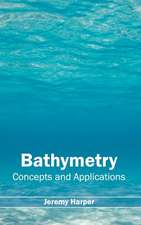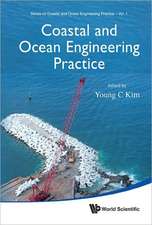Planktic Foraminifers in the Modern Ocean
Autor Ralf Schiebel, Christoph Hemlebenen Limba Engleză Paperback – 15 iul 2018
| Toate formatele și edițiile | Preț | Express |
|---|---|---|
| Paperback (1) | 587.85 lei 6-8 săpt. | |
| Springer Berlin, Heidelberg – 15 iul 2018 | 587.85 lei 6-8 săpt. | |
| Hardback (1) | 694.87 lei 3-5 săpt. | +35.43 lei 6-12 zile |
| Springer Berlin, Heidelberg – 24 feb 2017 | 694.87 lei 3-5 săpt. | +35.43 lei 6-12 zile |
Preț: 587.85 lei
Preț vechi: 691.59 lei
-15% Nou
Puncte Express: 882
Preț estimativ în valută:
112.49€ • 120.29$ • 93.79£
112.49€ • 120.29$ • 93.79£
Carte tipărită la comandă
Livrare economică 17 aprilie-01 mai
Preluare comenzi: 021 569.72.76
Specificații
ISBN-13: 9783662570524
ISBN-10: 3662570521
Ilustrații: XVII, 358 p. 164 illus., 54 illus. in color.
Dimensiuni: 178 x 254 mm
Greutate: 0.53 kg
Ediția:Softcover reprint of the original 1st ed. 2017
Editura: Springer Berlin, Heidelberg
Colecția Springer
Locul publicării:Berlin, Heidelberg, Germany
ISBN-10: 3662570521
Ilustrații: XVII, 358 p. 164 illus., 54 illus. in color.
Dimensiuni: 178 x 254 mm
Greutate: 0.53 kg
Ediția:Softcover reprint of the original 1st ed. 2017
Editura: Springer Berlin, Heidelberg
Colecția Springer
Locul publicării:Berlin, Heidelberg, Germany
Cuprins
Species Classification, Test Architecture, Shell Ontogeny, Species Phylogeny.- Sampling Methods and Faunal Analysis.- Cultivation.- Biology, Cellular Ultrastructure, Host Symbiont Relationships, Trophic Activity and Nutrition, Reproduction.- Molecular Genetics in Modern Species.- Ecology.- Stable Isotopes - Paleoceanography.- Element Ratios.- Sedimentation and Preservation of Tests.- Applications.
Recenzii
“This is an excellent state-of-the-art book containing a wealth of information attractively presented in well-written text and high quality plates and diagrams. As knowledge of modern processes is essential to the interpretation of the fossil record this book will be essential reading for biologists and geologists undertaking research on planktic foraminifera.” (John Murray, Newsletter of Micropaleontology, Issue 96, October, 2017)
Notă biografică
Dr. Ralf Schiebel, born 1965, is Professor in Geology at Angers University, France, since 2008. After studying and completing his PhD thesis at the Geology Department at Kiel University in 1992, he started work on planktic foraminifers at the lab of Ch. Hemleben at Tübingen University, Germany. In 2000, he accepted a position as Oberassistent at ETH Zurich, Switzerland, and in 2005 he joined the National Oceanography Centre in Southampton, UK, as a Lecturer in Paleoceanography. His main areas of research include the ecology, biogeochemistry, and paleoceanography of foraminifers. He is developing new methods in microscopy and image analysis in Earth sciences. Dr. Schiebel has participated in many research cruises to the North Atlantic, Mediterranean, Indian Ocean, Caribbean, and western Pacific.
Dr. Christoph Hemleben, born 1938, retired from his professorship in Geology and Paleontology at Tübingen University in 2002. He did his MSc (Diplom) at Munich University in 1964, and completed his PhD at Tübingen University in 1969. He has been extensively working on the biology, biomineralisation, and paleoceanography of foraminifers. He has published more than 100 papers in micropaleontology and sedimentology. The Springer-Verlag released his first book on Modern Planktonic Foraminifera together with Michael Spindler and Roger Anderson in 1989. He participated in more than 20 research cruises, on many of them as chief-scientist. With his retirement he
stopped teaching, but is still supporting research on an international level and co-authoring scientific publications.
Dr. Christoph Hemleben, born 1938, retired from his professorship in Geology and Paleontology at Tübingen University in 2002. He did his MSc (Diplom) at Munich University in 1964, and completed his PhD at Tübingen University in 1969. He has been extensively working on the biology, biomineralisation, and paleoceanography of foraminifers. He has published more than 100 papers in micropaleontology and sedimentology. The Springer-Verlag released his first book on Modern Planktonic Foraminifera together with Michael Spindler and Roger Anderson in 1989. He participated in more than 20 research cruises, on many of them as chief-scientist. With his retirement he
stopped teaching, but is still supporting research on an international level and co-authoring scientific publications.
Textul de pe ultima copertă
This book provides a comprehensive overview of the taxonomy, biology, sedimentation, and carbonate geochemistry of modern species. Students, early career and advanced scientists alike will profit from a broad synthesis of the current understanding of planktic foraminifers as an ecological indicator, biogeochemical factories, and proxies in paleoceanography. The classification of modern species is amply illustrated with electron and light microscope images of morphotypes, addresses the state-of-the-art of molecular genetics of species, and provides a detailed guide for any laboratory analyses. The biology of planktic foraminifers is extensively discussed in chapters dedicated to the cellular ultrastructure, nutrition, symbionts, reproduction, ontogeny, and test architecture. Building on the biological prerequisites, the distribution of planktic foraminifers is discussed at regional to global scale. The geochemistry and sedimentation of tests are considered in relation to the ecology ofthe living animal. In the final chapter, which examines the most common methods in planktic foraminifer research, hands-on information is provided on sampling, processing and analyzing samples in the laboratory, as well as selected established methods for data interpretation. The various topics discussed in this book are aimed at the application of planktic foraminifers as sensitive indicators of the changing climate and marine environment.
Caracteristici
Offers an extensively revised and updated successor to the renowned book "Modern Planktonic Foraminifera" by Hemleben et al. (published 20 years ago), including more recently developed approaches to the application of planktic foraminifera such as stable isotope geochemistry, element ratios, and molecular genetics Comprehensively treats modern planktic foraminifers and is suitable reading for all career stages from student to senior scientist Describes the applications of planktic foraminifera in protozoology, paleoceanography, biogeochemistry, micropaleontology, and in applied areas such as the hydrocarbon industry Includes supplementary material: sn.pub/extras





















